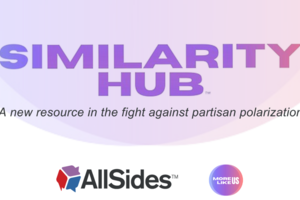Transparency Troubles: How the Associated Press Mixes News and Subjectivity

When an article is clearly labeled as “news” or “opinion,” do you read it with that in mind?
People coming to a site or clicking on a link expecting hard news are sometimes met with subjective analyses and opinionated angles, and content is not properly labeled. AllSides has found even historically trusted news sources, such as the Associated Press, sometimes fail to properly label content.
Journalism is practiced through various literary devices — no-frills fact-based news reports, perspectives-laden analyses or fully opinionated columns. Each is distinctly different; hard news gives us facts and tells us what happened, while analyses and opinion articles contextualize the events and provide readers with valuable insight and perspectives.
Some news outlets use content labels — such as “news,” “analysis,” “opinion,” or “perspective” — to help the reader distinguish content, but many don’t. For readers of modern news websites, both mainstream and alternative, inconsistent content labeling hinders media literacy and can even manipulate readers into thinking opinions are facts.
Without labels to differentiate content, readers can be confused or misled, and misinformation can fester. Data from the American Press Institute suggests nearly one-third of news consumers “find it very or somewhat difficult to tell the difference between news and opinion.”
The way we digest and use information depends largely on the way it is presented to us. Is this an objective fact? Am I getting the full story? Or is the author leaving something out to achieve a personal or intellectual narrative?
This is why labeling content as news, opinion or analysis is so important.
(Related: How AllSides Labels Curated Content)
The Associated Press (AP), widely considered to be a worldwide leader in journalism, describes itself as the “most trusted source of fast, accurate, unbiased news.” This suggests the site is strictly dedicated to news — but it isn’t.
Recently, the AP has mixed subjective, analysis-based content in with its hard news reporting. And while this content is sometimes distinguished by an “Analysis” label, other times it’s not.
Last week, the AP’s article mentioning First Lady Melania Trump’s Republican National Convention (RNC) speech was rife with examples of subjective analysis also bordering on opinion. But this article lacked an “analysis” label and was shown alongside the rest of the AP’s news content.
In the article, the authors break down everything from the tone of the RNC (calling it “dark” and “ominous,” which is sensationalist language, and is a subjective judgement), to President Trump’s poll numbers, to Melania Trump’s history, to other RNC speakers. In one instance, the writers offer a subjective interpretation of Trump’s campaign messages:
But most speakers have stuck to Trump’s law-and-order message, warning that electing Democrat Joe Biden would lead to violence in American cities spilling into the suburbs, a message with racist undertones.
To say that message has “racist undertones” is pure opinion, and has no place in a news report. In this case, it’s up to readers to judge whether they believe something is racist.
(Related: Sensationalist News is Everywhere. Here’s How AllSides Bucks the Trend)
The authors also described one of the RNC speakers as having “assailed” the media, while framing Melania in a negative light — all examples of media bias through spin:
At her 2016 convention speech, [Melania Trump] included passages similar to what former first lady Michelle Obama had said in her first convention speech. A speechwriter for the Trump Organization later took the blame. Mrs. Trump has not always been in lockstep with the president.
The third sentence in this quote is an opinion statement presented as fact and without hard evidence. How has Melania illustrated she has not always been in lockstep with the president? Though this article is structured like an analysis and has many instances of subjective language, without a label, the AP presented it to readers as an objective news report. (AP appears to have removed the final sentence of the paragraph. No editor’s note was added to the story.)
In August, an article about President Trump’s crisis mitigation efforts appeared in the AP under the “Analysis” label. While mostly written as a news analysis rather than a report, the author’s subjective opinion shines through at times:
Like no president before him, Trump fixates on his media coverage, intent on not just winning a news cycle but winning any single moment’s social media headline or cable news chyron, according to three current or former campaign officials not authorized to publicly discuss private conversations. That emphasis on tactics rather than strategy, gunning for a short-term win without consideration that it could also lead to long-term trouble, has allowed the Republican president to survive threats that imperiled his presidency but also may have contributed to the polling slide that began soon after the coronavirus pandemic reached American shores.
The author writes that Trump is “gunning for a short-term win without consideration that it could also lead to long-term trouble,” with no cited proof, a type of media bias known as mind reading. This subjective interpretation frames Trump’s media tactics in a negative light, while some might praise these tactics as evidence of hands-on, involved leadership. This kind of interpretation is better suited to an opinion column than a news analysis.
Inconsistent or misused labels do more harm than good — especially when people are coming to the AP expecting balanced news coverage.
Media bias is not exclusive to the AP; AllSides rates the bias of over 800 publications and sources throughout the political spectrum. However, AllSides reviews have consistently found AP to inject subjective statements and opinions in what’s portrayed as news coverage.
AllSides has found news content from other prominent outlets on both sides — the left-rated Washington Post and right-rated Fox News, as examples — to show bias in elements like photo choice and bias by omission, but not as much for mixing overtly subjective writing into news reporting when compared to the AP.
The AP has taken flak for a shift toward subjectivity in its news reporting, not just from media critics, but from small-town communities like the one in Lufkin, Texas. Readers of the Lufkin Daily News decried a July 4 AP story about Trump’s Mt. Rushmore speech for exhibiting bias, prompting an apology from the local paper’s editor.
Places like Lufkin and many others rely on the AP for “fast, accurate, unbiased news” to help fill their newspaper and keep smaller communities informed on a national level. A lack of diligence in separating objectivity from opinion impedes that goal. Without clear content labeling, news readers of the hundreds of small hyperlocals throughout the U.S. that are fueled by AP content — who may need it more than anyone — aren’t getting what they pay for.
To minimize subjectivity on our part, AllSides typically refers to the original publisher’s labels for its content, rather than employing our own. In other words, a “news” piece from AP will be labeled as a News Report by us, even if we think it’s more of an analysis or opinion piece. We’re working to develop a better way of labeling content accurately and fairly while ensuring our methods are ethical and in the interest of news literacy.
We’ll take every opportunity to advance media literacy, helping you to decide for yourself and hold media outlets accountable. But we can’t catch every example. When you spot something questionable or possibly misleading, email us: feedback@allsides.com.
Micaela Ricaforte is AllSides.com’s News Editor. She has a Center bias.
This piece was reviewed by AllSides CEO John Gable (Lean Right bias); Managing Editor Henry A. Brechter (Center bias); Director of Marketing Julie Mastrine (Lean Right bias); and Content and Research Intern Rick Wytmar (Lean Left bias).

April 25th, 2024


April 24th, 2024

April 24th, 2024